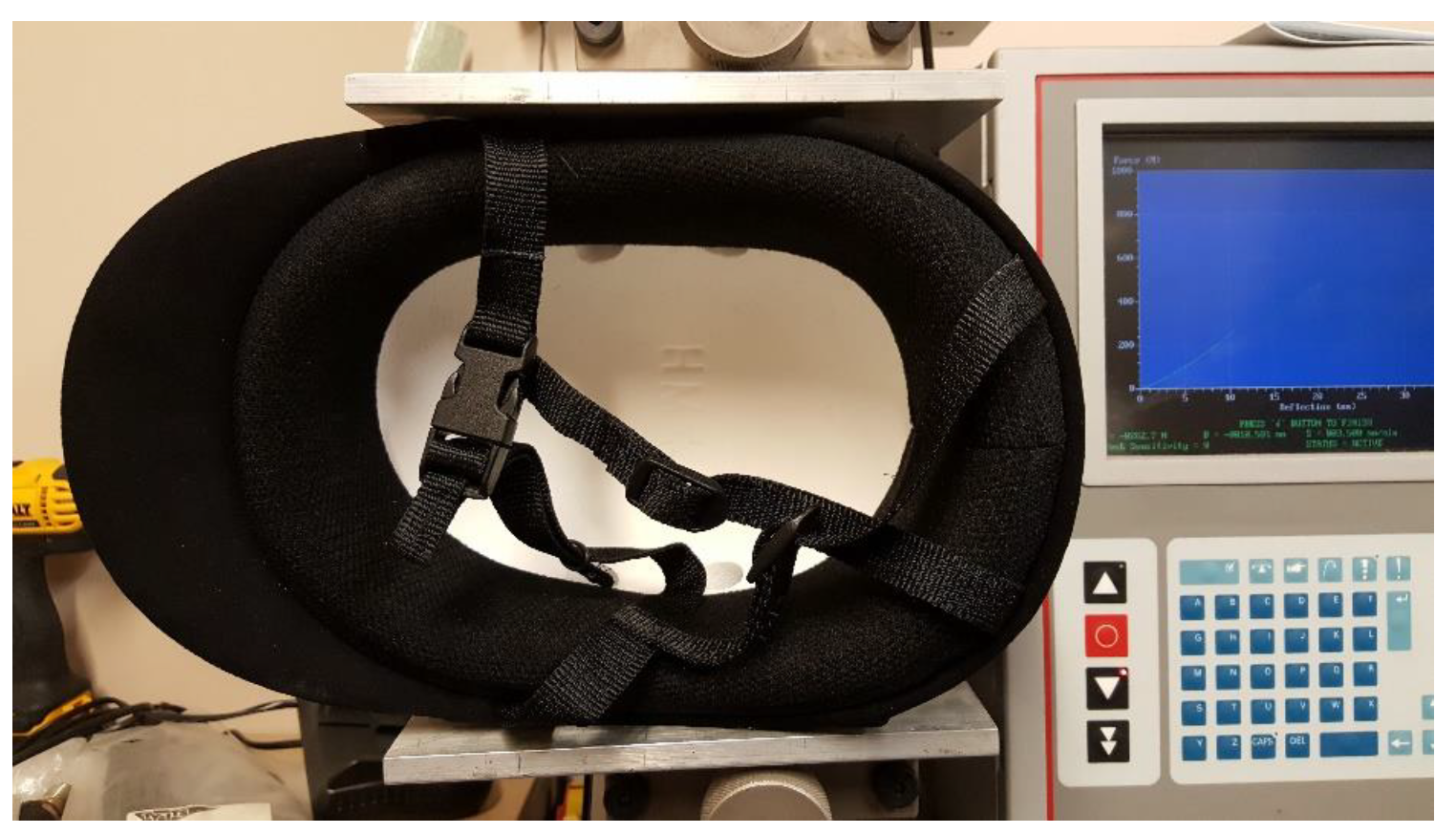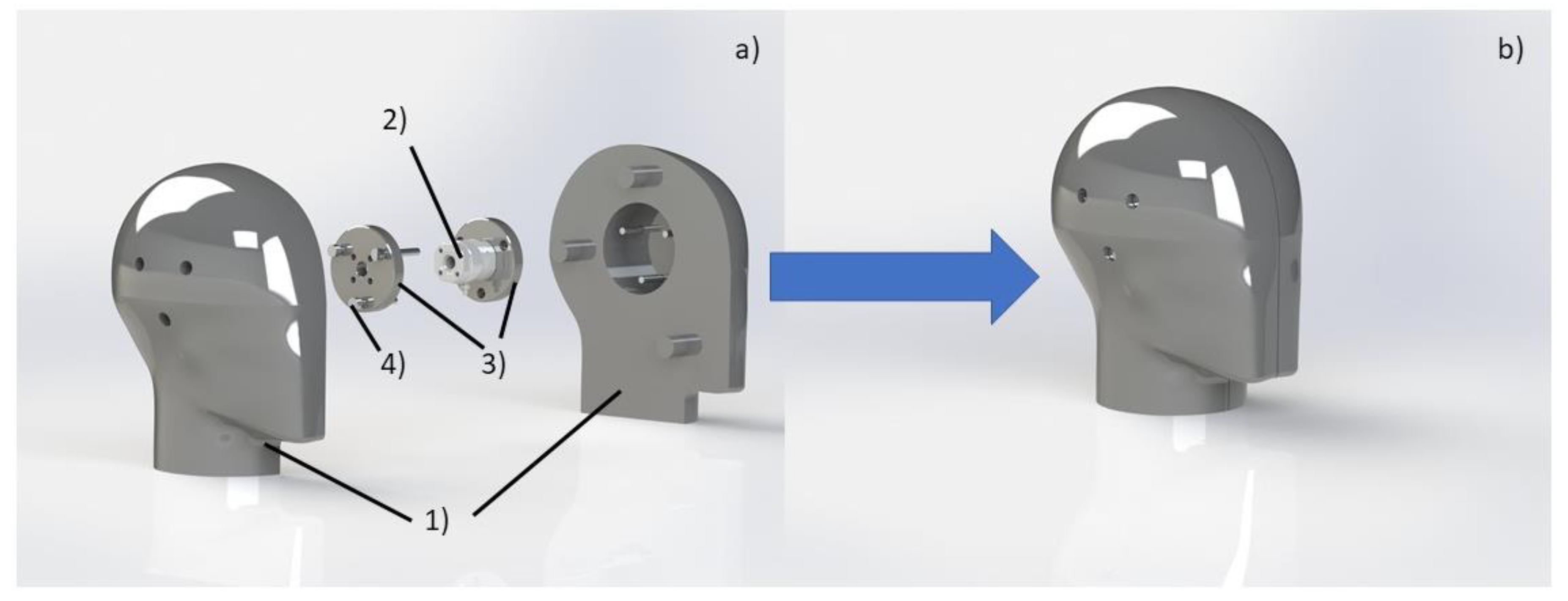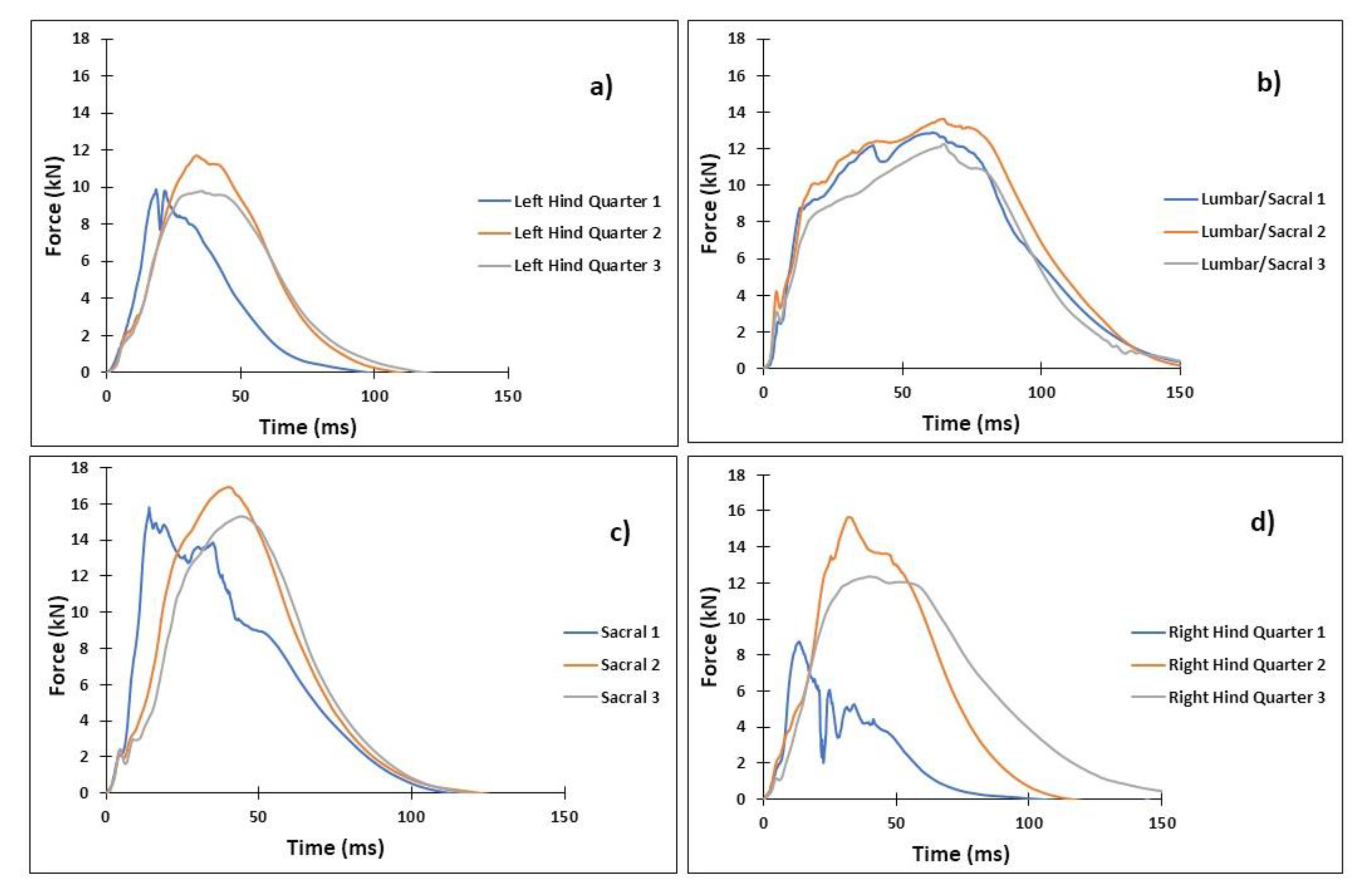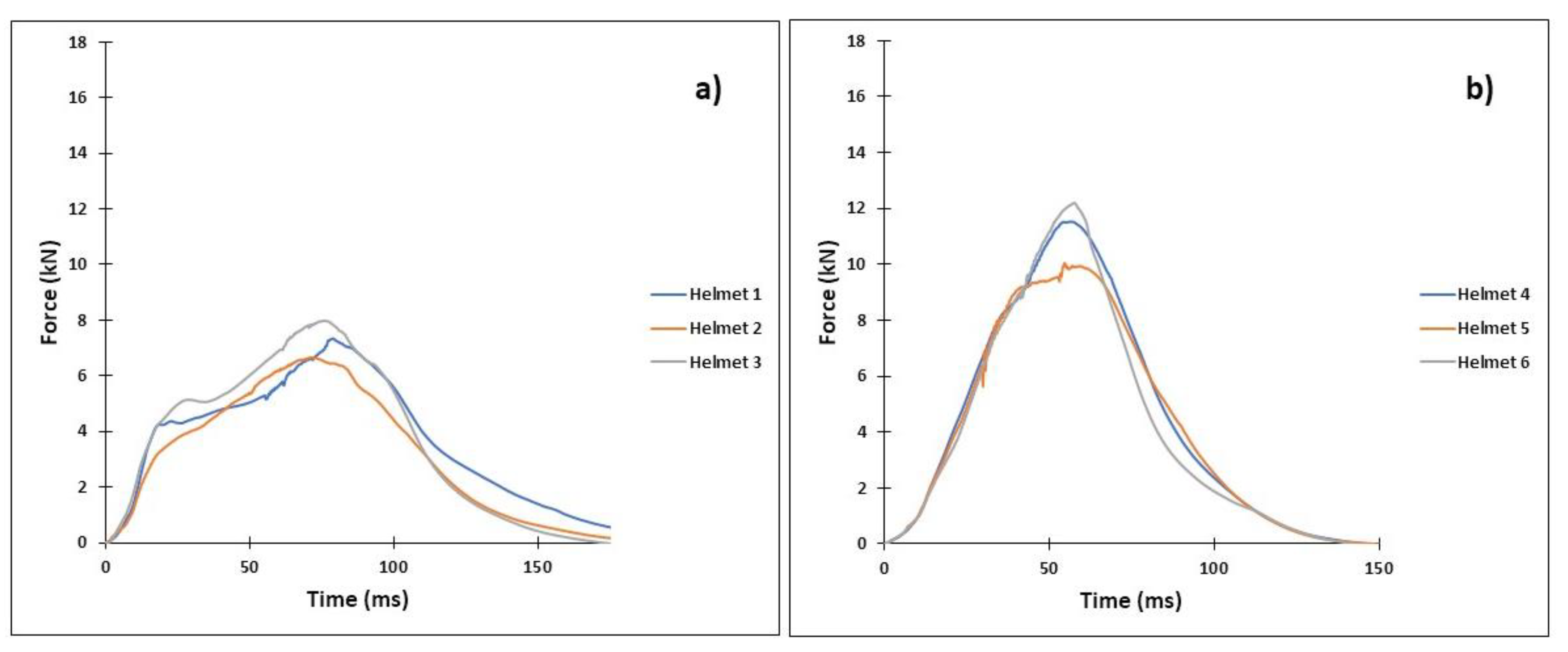An Evidence Basis for Future Equestrian Helmet Lateral Crush Certification Tests
Abstract
1. Introduction
2. Materials and Methods
2.1. Instrumented Headform
2.2. Equine Cadaver Drop Tests
3. Results
3.1. Horse 1 Drop Tests
3.2. Horse 2 Drop Tests
3.3. Horse 2 Helmeted Drop Tests
3.4. Helmeted vs. Un-helmeted vs. Impact Location
4. Discussion
4.1. Horse Impact Data
4.2. Helmet Effects
4.3. Skull Fracture
4.4. Limitations
4.5. Future Work
5. Conclusions
Author Contributions
Funding
Conflicts of Interest
Declaration of Interest Statement
References
- Abu-Zidan, F.M.; Rao, S. Factors affecting the severity of horse-related injuries. Injury 2003, 34, 897–900. [Google Scholar] [CrossRef]
- Ball, C.G.; Ball, J.E.; Kirkpatrick, A.W.; Mulloy, R.H. Equestrian injuries: Incidence, injury patterns, and risk factors for 10 years of major traumatic injuries. Am. J. Surg. 2007, 193, 636–640. [Google Scholar] [CrossRef] [PubMed]
- DeBenedette, V. People and horses: The risks of riding. Physician Sports Med. 1989, 17, 250–254. [Google Scholar] [CrossRef] [PubMed]
- Balendra, G.; Turner, M.; McCrory, P.; Halley, W. Injuries in amateur horse racing (point to point racing) in Great Britain and Ireland during 1993–2006. Br. J. Sports Med. 2007, 41, 162. [Google Scholar] [CrossRef] [PubMed]
- Turner, M.; McCrory, P.; Halley, W. Injuries in professional horse racing in Great Britain and the Republic of Ireland during 1992–2000. Br. J. Sports Med. 2002, 36, 403. [Google Scholar] [CrossRef] [PubMed]
- Forero Rueda, M.A.; Halley, W.L.; Gilchrist, M.D. Fall and injury incidence rates of jockeys while racing in Ireland, France and Britain. Injury 2010, 41, 533–539. [Google Scholar] [CrossRef] [PubMed]
- ASTM F1163-15. Standard Specification for Protective Headgear Used in Horse Sports and Horseback Riding; American Soc. for Testing & Materials: West Conshohocken, PA, USA, 2015. [Google Scholar]
- EN 1384:2017. Helmets for Equestrian Activities; British Standards Institution: London, UK, 2017. [Google Scholar]
- PAS015:2011. Helmets for Equestrian Use; British Standards Institution: London, UK, 2011. [Google Scholar]
- Newman, J.A. Modern Sports Helmets: Their History, Science, and Art; Schiffer Pub: Atglen, PA, USA, 2007. [Google Scholar]
- Becker, E.B. Helmet Development and Standards. Frontiers in Head and Neck Trauma Clinical and Biomedical; Yoganandan, N., Ed.; IOS Press: Amsterdam, The Netherlands, 1998. [Google Scholar]
- Snell E2016. Standard for Protective Headgear for use in Horseback Riding; Snell Memorial Foundation: North Highlands, CA, USA, 2016. [Google Scholar]
- Connor, T.A.; Clark, J.M.; Jayamohan, J.; Stewart, M.; McGoldrick, A.; Williams, C.; Seemungal, B.M.; Smith, R.; Burek, R.; Gilchrist, M.D. Do equestrian helmets prevent concussion? A retrospective analysis of head injuries and helmet damage from real-world equestrian accidents. Sports Med. Open 2019, 5, 19. [Google Scholar] [CrossRef] [PubMed]
- Hynd, D.; Muirhead, M.; Carroll, J.; Barr, A.; Clissold, J. Evaluation of the effectiveness of an exemplar equestrian air jacket against crush injuries. In Proceedings of the IRCOBI Conference, Malaga, Spain, 14–16 September 2016. [Google Scholar]
- Connor, T.A.; Stewart, M.; Burek, R.; Gilchrist, M.D. Influence of headform mass and inertia on the response to oblique impacts. Int. J. Crashworthiness 2015, 24, 677–698. [Google Scholar] [CrossRef]
- ISO 6487. Road vehicles—Measurement techniques in impact tests—Instrumentation; International Standards Organisation: Geneva, Switzerland, 2015. [Google Scholar]
- Clark, J.M.; Adanty, K.; Post, A.; Hoshizaki, T.B.; Clissold, J.; McGoldrick, A.; Hill, J.; NíAnnaidh, A.; Gilchrist, M.D. Proposed injury thresholds for concussion in equestrian sports. J. Sci. Med. Sport. 2020, 23, 222–236. [Google Scholar] [CrossRef] [PubMed]
- Martinson, K.L.; Coleman, R.C.; Rendahl, A.K.; Fang, Z.; McCue, M.E. Estimation of body weight and development of a body weight score for adult equids using morphometric measurements. J. Anim. Sci. 2014, 92, 2230–2238. [Google Scholar] [CrossRef] [PubMed]
- Allsop, D.L.; Perl, T.R.; Warner, C.Y. Force/deflection and fracture characteristics of the temporo-parietal region of the human head. SAE Trans. 1991, 100, 2009–2018. [Google Scholar]
- Yoganandan, N.; Pintar, F.A.; Sances, A., Jr. Biomechanics of skull fracture. J. Neurotrauma. 1995, 12, 659–668. [Google Scholar] [CrossRef] [PubMed]
- Kleiven, S. Why most traumatic brain injuries are not caused by linear acceleration but skull fractures are. Front. Bioeng. Biotechnol. 2013, 1, 15. [Google Scholar] [CrossRef] [PubMed]
- Got, C.; Patel, A.; Fayon, A.; Tarriere, C.; Walfisch, G. Results of Experimental Head Impacts on Cadavers: The Various Data Obtained and Their Relations to Some Measured Physical Parameters; SAE Tech. Pap. 780887; Society of Automotive Engineers: Warrendale, PA, USA, 1978. [Google Scholar]
- McIntosh, A.S.; Svensson, N.L.; Kallieris, D.; Mattern, R.; Krabbel, G.; Ikels, K. Head impact tolerance in side impacts. In Proceedings of the 15th International Technical Conference on the Enhanced Safety of Vehicles, Melbourne, Australia, 13–15 May 1996; pp. 1273–1280. [Google Scholar]
- Hodgson, V.R.; Thomas, L.M. Breaking Strength of the Human Skull vs. Impact Surface Curvature, DOT-HS-146-2-230; U.S. Department of Transportation, National Highway Traffic Safety Administration: Detroit, MI, USA, 1973.
- Hodgson, V.R.; Thomas, L.M. Comparison of head acceleration injury indices in cadaver skull fracture. SAE Trans. 1971, 80, 2894–2902. [Google Scholar]
- Loyd, A.M.; Nightingale, R.W.; Luck, J.F.; Cutcliffe, H.C.; Myers, B.S. The response of the pediatric head to impacts onto a rigid surface. J. Biomech. 2019, 93, 167–176. [Google Scholar] [CrossRef] [PubMed]
- Trotta, A.; Annaidh, A.N.; Burek, R.O.; Pelgrims, B.; Ivens, J. Evaluation of the head-helmet sliding properties in an impact test. J. Biomech. 2018, 75, 28–34. [Google Scholar] [CrossRef] [PubMed]







| Test no. | Impact Location | Peak Force (kN) | Time to Peak (ms) |
|---|---|---|---|
| 1 | Left Hind Quarter | 11.65 | 17.83 |
| 2 | Left Hind Quarter | 15.96 | 22.44 |
| 3 | Left Hind Quarter | 13.61 | 28 |
| Mean | 13.74 | 22.76 | |
| SD | 2.16 | 5.09 | |
| 1 | Lumbosacral Junction | 6.53 | 17.48 |
| 2 | Lumbosacral Junction | 8.28 | 70.04 |
| 3 | Lumbosacral Junction | 10.15 | 68.72 |
| Mean | 8.32 | 52.08 | |
| SD | 1.81 | 29.97 | |
| 1 | Sacral Vertebrae | 16.85 | 21.08 |
| 2 | Sacral Vertebrae | 14.89 | 25.16 |
| 3 | Sacral Vertebrae | 14.98 | 23.32 |
| Mean | 15.57 | 23.19 | |
| SD | 1.11 | 2.02 | |
| 1 | Right Hind Quarter | 7.11 | 31.72 |
| 2 | Right Hind Quarter | 10.01 | 20.76 |
| 3 | Right Hind Quarter | 6.6 | 28.28 |
| Mean | 7.91 | 26.92 | |
| SD | 1.84 | 5.61 | |
| Mean (All Locations) | 11.39 | 31.24 | |
| SD (All Locations) | 3.80 | 18.31 |
| Test no. | Impact Location | Peak Force (kN) | Time to Peak (ms) |
|---|---|---|---|
| 1 | Left Hind Quarter | 9.89 | 18.28 |
| 2 | Left Hind Quarter | 11.7 | 33.48 |
| 3 | Left Hind Quarter | 9.8 | 35.44 |
| Mean | 10.47 | 29.07 | |
| SD | 1.08 | 9.39 | |
| 1 | Lumbosacral Junction | 12.89 | 61.04 |
| 2 | Lumbosacral Junction | 13.64 | 64.6 |
| 3 | Lumbosacral Junction | 12.27 | 64.88 |
| Mean | 12.93 | 63.51 | |
| SD | 0.69 | 2.14 | |
| 1 | Sacral Vertebrae | 15.81 | 14.12 |
| 2 | Sacral Vertebrae | 16.94 | 40.36 |
| 3 | Sacral Vertebrae | 15.31 | 44.32 |
| Mean | 16.02 | 32.93 | |
| SD | 0.83 | 16.41 | |
| 1 | Right Hind Quarter | 8.74 | 13.52 |
| 2 | Right Hind Quarter | 15.66 | 31.93 |
| 3 | Right Hind Quarter | 12.25 | 39.84 |
| Mean | 12.25 | 28.43 | |
| SD | 3.46 | 13.5 | |
| Mean (All Locations) | 12.91 | 38.48 | |
| SD (All Locations) | 2.65 | 18.16 |
| Test no. | Impact Location | Peak Force (kN) | Time to Peak (ms) |
|---|---|---|---|
| 1 | Sacral Vertebrae | 11.53 | 56.68 |
| 2 | Sacral Vertebrae | 10.05 | 54.6 |
| 3 | Sacral Vertebrae | 12.2 | 57.64 |
| Mean | 11.26 | 56.31 | |
| SD | 1.1 | 1.55 | |
| 1 | Lumbosacral Junction | 7.34 | 78.8 |
| 2 | Lumbosacral Junction | 6.66 | 71.56 |
| 3 | Lumbosacral Junction | 7.97 | 76.4 |
| Mean | 7.33 | 75.59 | |
| SD | 0.66 | 3.69 | |
| Mean (All Locations) | 9.29 | 65.95 | |
| SD (All Locations) | 2.30 | 10.86 |
| Helmeted vs. Un-Helmeted Impacts | p-Value | % Difference |
|---|---|---|
| Combined Locations | <0.001 | 43.60 |
| Lumbosacral Junction | <0.001 | 55.40 |
| Sacral Vertebrae | <0.05 | 36.73 |
| Impact Location Comparison | p-Value | % Difference |
|---|---|---|
| LHQ vs. RHQ | >0.005 | 18.41 |
| LHQ vs. Lumbosacral Junction | >0.005 | 12.98 |
| LHQ vs. Sacral Vertebrae | <0.005 | 26.49 |
| Lumbosacral Junction vs. Sacral Vertebrae | <0.001 | 39.13 |
| Lumbosacral Junction vs. RHQ | >0.005 | 5.46 |
| Sacral Vertebrae vs. RHQ | <0.005 | 44.36 |
© 2020 by the authors. Licensee MDPI, Basel, Switzerland. This article is an open access article distributed under the terms and conditions of the Creative Commons Attribution (CC BY) license (http://creativecommons.org/licenses/by/4.0/).
Share and Cite
Connor, T.A.; Clark, J.M.; Brama, P.; Stewart, M.; Ní Annaidh, A.; Gilchrist, M.D. An Evidence Basis for Future Equestrian Helmet Lateral Crush Certification Tests. Appl. Sci. 2020, 10, 2623. https://doi.org/10.3390/app10072623
Connor TA, Clark JM, Brama P, Stewart M, Ní Annaidh A, Gilchrist MD. An Evidence Basis for Future Equestrian Helmet Lateral Crush Certification Tests. Applied Sciences. 2020; 10(7):2623. https://doi.org/10.3390/app10072623
Chicago/Turabian StyleConnor, Thomas A., J. Michio Clark, Pieter Brama, Matt Stewart, Aisling Ní Annaidh, and Michael D. Gilchrist. 2020. "An Evidence Basis for Future Equestrian Helmet Lateral Crush Certification Tests" Applied Sciences 10, no. 7: 2623. https://doi.org/10.3390/app10072623
APA StyleConnor, T. A., Clark, J. M., Brama, P., Stewart, M., Ní Annaidh, A., & Gilchrist, M. D. (2020). An Evidence Basis for Future Equestrian Helmet Lateral Crush Certification Tests. Applied Sciences, 10(7), 2623. https://doi.org/10.3390/app10072623





